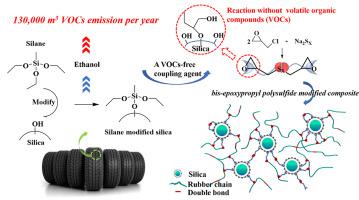Composites Part B: Engineering ( IF 12.7 ) Pub Date : 2020-08-13 , DOI: 10.1016/j.compositesb.2020.108301 Neng Ye , Junchi Zheng , Xin Ye , Jiajia Xue , Dongli Han , Haoshu Xu , Zhao Wang , Liqun Zhang

|
Nano-silica is an important component for producing elastomer composites used for fabricating “green tires.” However, the poor dispersion of silica particles in the rubber matrix and the emission of volatile organic compounds (VOCs) during the silica modification limit the applications of the modifiers. Here, bis-epoxypropyl polysulfide (BEP), a novel epoxy-type coupling agent, was designed and synthesized for nano-silica modification to cause an interfacial interaction between nano-silica and the rubber matrix and avoid VOC emission. The thermogravimetric analysis result and the bound rubber content show that BEP effectively built a bridge between the nano-silica and the rubber, which led to a strong interfacial effect and promising mechanical performance characteristics. The silica dispersion in solution-polymerized styrene-butadiene rubber (SSBR) was studied using a transmission electron microscope and a rubber process analyzer, and the results demonstrate that BEP could significantly improve silica dispersion. The static and dynamic mechanical performance results indicate that BEP is a valid coupling agent that can achieve silica/SSBR composites with high moduli and reinforcement indices. Moreover, the combination of BEP and bis-(γ-triethoxysilylpropyl)-tetrasulfide (TESPT) was also found to demonstrate a synergistic effect, which resulted in excellent static and dynamic performances of silica/SSBR composites for preparing higher-energy-efficient “green tires.”
中文翻译:

使用不含VOC的界面二氧化硅偶联剂增强橡胶复合材料的性能
纳米二氧化硅是生产用于制造“生胎”的弹性体复合材料的重要成分。然而,二氧化硅颗粒在橡胶基质中的分散性差以及在二氧化硅改性过程中挥发性有机化合物(VOC)的排放限制了改性剂的应用。在此,设计并合成了一种新型的环氧型偶联剂双环氧丙基多硫化物(BEP),用于纳米二氧化硅的改性,以引起纳米二氧化硅与橡胶基体之间的界面相互作用并避免VOC排放。热重分析结果和结合橡胶的含量表明,BEP有效地在纳米二氧化硅和橡胶之间架起了桥梁,从而产生了很强的界面效应和良好的机械性能。使用透射电子显微镜和橡胶过程分析仪研究了溶液聚合的丁苯橡胶(SSBR)中的二氧化硅分散体,结果表明BEP可以显着改善二氧化硅分散体。静态和动态力学性能结果表明,BEP是一种有效的偶联剂,可以实现具有高模量和增强指数的二氧化硅/ SSBR复合材料。此外,还发现BEP和双-(γ-三乙氧基甲硅烷基丙基)-四硫化物(TESPT)的组合具有协同作用,从而使二氧化硅/ SSBR复合材料具有优异的静态和动态性能,可制备更高能效的“绿色”轮胎。” 结果表明,BEP可以显着改善二氧化硅的分散性。静态和动态力学性能结果表明,BEP是一种有效的偶联剂,可以实现具有高模量和增强指数的二氧化硅/ SSBR复合材料。此外,还发现BEP和双-(γ-三乙氧基甲硅烷基丙基)-四硫化物(TESPT)的组合具有协同作用,从而使二氧化硅/ SSBR复合材料具有优异的静态和动态性能,可制备更高能效的“绿色”轮胎。” 结果表明,BEP可以显着改善二氧化硅的分散性。静态和动态力学性能结果表明,BEP是一种有效的偶联剂,可以实现具有高模量和增强指数的二氧化硅/ SSBR复合材料。此外,还发现BEP和双-(γ-三乙氧基甲硅烷基丙基)-四硫化物(TESPT)的组合具有协同作用,从而使二氧化硅/ SSBR复合材料具有优异的静态和动态性能,可制备更高能效的“绿色”轮胎。”









































 京公网安备 11010802027423号
京公网安备 11010802027423号